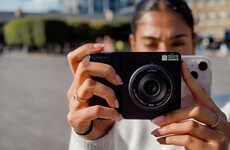The 'Theia' handheld guidance device has been designed by Anthony Camu as an intuitive solution for those with visual impairments to utilize in place of a guide dog or human companion. The device works by being held in the hand and utilizing shifting components inside to guide the user much in the same way they would be pulled by a dog. This would make the device great for those who live in high-rise buildings or those who can't afford to keep a dog for a better sense of independence.
The 'Theia' handheld guidance device is equipped with LiDAR technology to scan the environment 10-meters ahead of the user to guide them away from obstacles and enables 270-degrees of visibility.
Robotic Visual Impairment Guides
The 'Theia' Handheld Guidance Device is a Guide Dog Alternative
Trend Themes
1. Robotic Assistance Devices - Opportunity for disruptive innovation in designing more assistive and intuitive devices for the visually impaired.
2. Lidar Technology Integration - Opportunity for disruptive innovation in integrating LiDAR technology into other assistive devices, such as walkers or canes.
3. Emergency Response Robotics - Opportunity for disruptive innovation in utilizing LiDAR technology for emergency response robots to navigate through disaster-stricken areas.
Industry Implications
1. Assistive Technology - The visually impaired community could benefit from more inclusive and affordable solutions such as the Theia guidance device.
2. Robotics - There is room for disruptive innovation in integrating LiDAR technology into other robots for more precise functionality and increased safety measures.
3. Emergency Response - Emergency response teams could benefit from the integration of LiDAR technology in robotics that could navigate through disaster zones and assess damage compared to search and rescue dogs.




